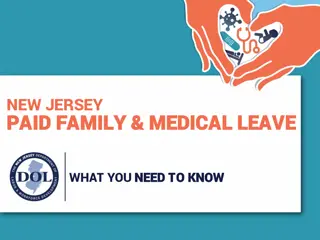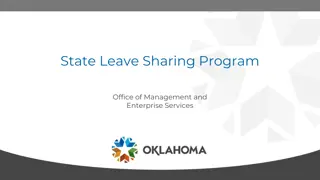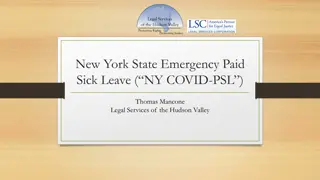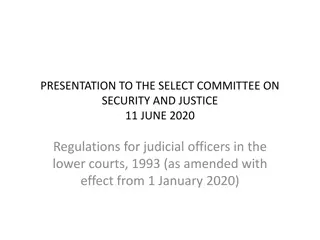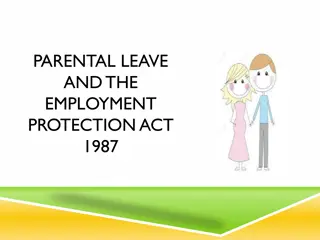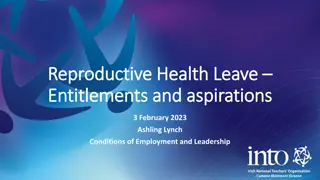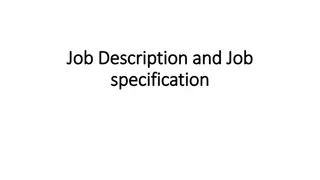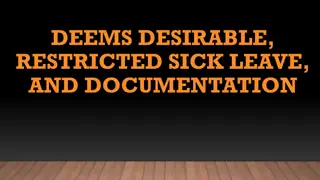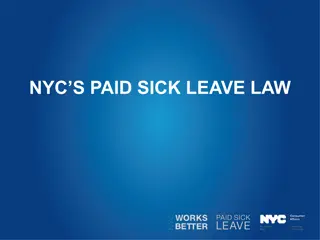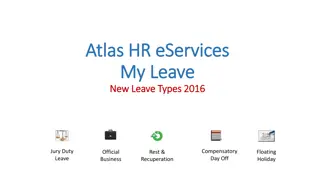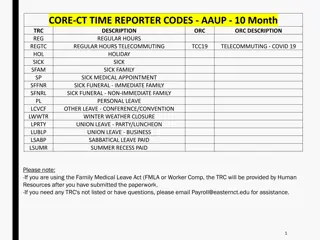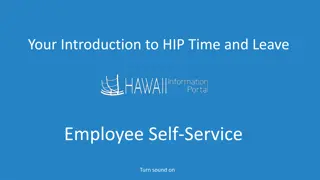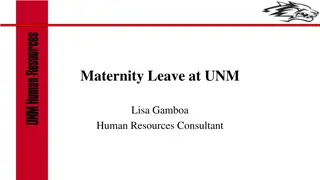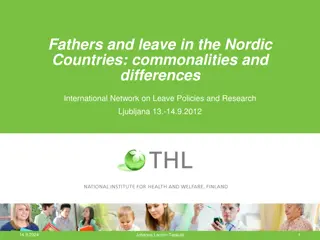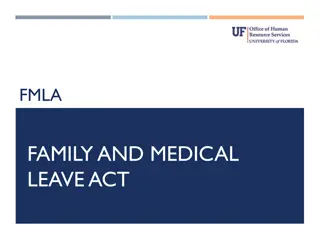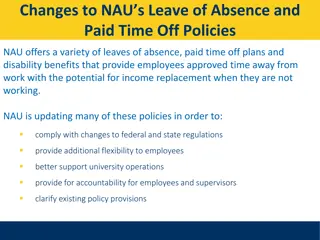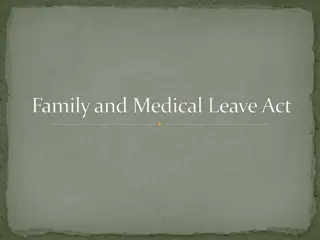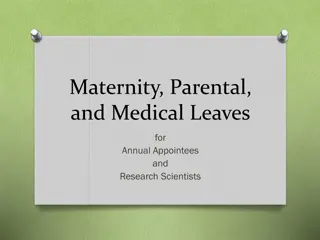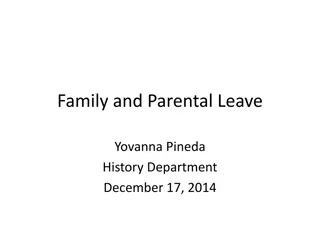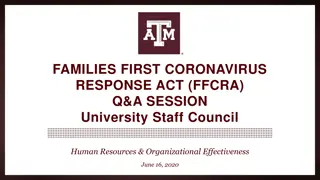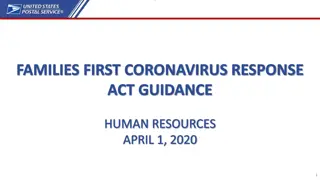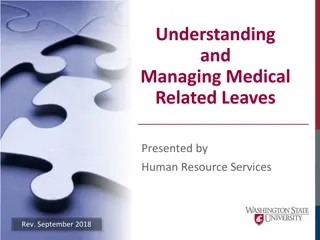Overview of Leave Laws and Job Protection Guidelines
Providing a comprehensive overview of various leave laws, job-protected leave, and income replacement options for employees in Connecticut, including details on Federal FMLA, CT Paid Leave, CTFMLA, Workers Compensation, Paid Sick Leave, Americans with Disabilities Act, Pregnancy Disability Act, and CT Fair Employment Practice Act. The content also outlines job protection rights under CTFMLA and Federal FMLA, emphasizing return rights and benefits protection for employees.
Download Presentation

Please find below an Image/Link to download the presentation.
The content on the website is provided AS IS for your information and personal use only. It may not be sold, licensed, or shared on other websites without obtaining consent from the author. Download presentation by click this link. If you encounter any issues during the download, it is possible that the publisher has removed the file from their server.
E N D
Presentation Transcript
CTFMLA in 2022 Legal Division CT Department of Labor 1
DISCLAIMER This guidance is designed to provide a service to the employers and employees of this state. It does not constitute legal advice. Although the Labor Department makes every effort to provide quality information, it makes no claims, promises or guarantees about the accuracy or completeness of the information contained herein. 2
OVERVIEW OF LEAVE LAWS LAWS PROVIDING JOB-PROTECTED LEAVE LAWS PROVIDING INCOME REPLACEMENT DURING LEAVE Federal FMLA (50+ employees in a 75-mile radius for private employers and 1+ for public employers) CT Paid Leave ( CTPL ) (1+ employees working in CT and self-employed opting in) CTFMLA (1+ employees working in CT) Workers Compensation - for covered on-the-job injuries/illnesses Workers Compensation - for covered on-the-job injuries/illness Paid Sick Leave (50 or more employees in CT on 10/1 of each year) - up to 40 hours in a one-year period only applies to 69 categories of service workers Americans with Disabilities Act (15+ employees) - Leave may be a reasonable accommodation Pregnancy Disability Act (15+ employees) - Leave may be a reasonable accommodation CT Fair Employment Practice Act (3+ employees) - Leave may be a reasonable accommodation Paid Sick Leave (50 or more employees in CT on 10/1 of each year) - up to 40 hours in a one-year period only applies to 69 categories of service workers
JOB PROTECTION - CTFMLA 12 weeks every 12 months Job protected - return to same or equivalent job Benefits protected General rule - treat employee as though they never took leave Employee may take up to two additional weeks of leave during the 12-month period for a serious health condition resulting in incapacitation that occurs during a pregnancy 4
JOB PROTECTION - FEDERAL FMLA Federal FMLA - 12 weeks every 12 months Job protected - return to same or equivalent job Benefits protected Continuation of employer-sponsored health benefits during leave 5
CT Paid Leave - Only Income Replacement No job protection 12 weeks every 12 months 6
What is the length of the FMLA leave/paid leave benefits? Federal FMLA job-protected leave CTPL paid leave benefits (as of 1/1/22) CTFMLA job-protected leave (as of 1/1/22) Up to 12 weeks in a 12-month period for all leave reasons except: Up to 12 weeks in a 12-month period for all leave reasons except: Up to 12 weeks in a 12-month period for all leave reasons including military caregiver leave except: Up to 26 weeks in a 12-month period for military caregiver leave Up to 26 weeks in a 12-month period for military caregiver leave Up to 12 days of the 12 weeks could be used for income replacement during family violence leave ***Under 31-51ss (not CTFMLA), an employee who is a victim of family violence may use up to 12 days of leave during any calendar year in which such leave is reasonably necessary.Leave shall not affect any other leave provided under state or federal law An employee may be eligible for 2 additional weeks of leave for incapacity due to a serious health condition during pregnancy An employee may be eligible for 2 additional weeks of income replacement during leave for incapacity due a serious health condition during pregnancy
12-MONTH PERIOD - CTFMLA and FEDERAL FMLA To determine the 12-month period, the employer must utilize any one of the following: A calendar year; any fixed 12-month period, such as a fiscal year or a 12-month period measured forward from an employee's first date of employment; a 12-month period measured forward from an employee's first day of leave taken; or a rolling 12-month period measured backward from the date employee takes FMLA leave. 8
CTFMLA and FEDERAL FMLA WHEN BOTH SPOUSES WORK FOR THE SAME EMPLOYER When both spouses work for the same employer, they may be limited to a combined total of 12 weeks of leave during any 12-month period if the leave is for: Birth and bonding; Adoption or placement of a foster child, OR Care for family member Note: Spouses working for the same employer may be limited to a combined total of 26 weeks for military caregiver leave. 9
EXAMPLE WHEN BOTH SPOUSES WORK FOR THE SAME EMPLOYER Wife is disabled for 8 weeks after the birth. Husband is entitled to take 8 weeks to care for wife with serious health condition. Even though each has 4 weeks remaining, they may only use a total of 4 weeks combined for bonding because weeks must be shared if spouses, both working for the same employer, want bonding time. Wife uses 4 weeks for bonding Wife has used a total of 12 weeks of CT FMLA 8 for SHC + 4 for bonding = CT FMLA leave exhausted Husband may not use any time for bonding because wife is using the 4 remaining shared weeks for bonding Husband has used a total of 8 weeks of CT FMLA, and has 4 weeks left to use for other qualifying reasons (not bonding or caring for a family member) 10
WHAT TRIGGERS THE CTPL and FMLA? The birth of a child and care within the first year after birth; The placement of a child with employee for adoption or foster care and care within the first year after placement; To care for a family member with a serious health condition; Because of the employee s own serious health condition; To serve as an organ or bone marrow donor; To address qualifying exigencies arising from a spouse, son, daughter or parent s active duty service in the armed forces; To care for a spouse, son, daughter, parent or next of kin with a serious injury or illness incurred on active duty in the armed forces Federal FMLA does not include leave for a family member limited to spouse, son, daughter, or parent, which are not as broadly defined 11
MILITARY FMLA - CT MILITARY CAREGIVER LEAVE (care for a seriously ill or injured servicemember) 26 weeks of leave allowed for: Spouse, child (of any age), parent, or next-of-kin of a current member of the Armed Forces where the servicemember is: Undergoing medical treatment, recuperation or therapy Otherwise in outpatient status; OR On the temporary disability retired list for a serious injury or illness incurred in the line of duty. Applies on a per-servicemember, per-injury basis, so employee may receive up to 26 weeks of leave to care for different servicemembers or same servicemember with a different injury/illness, but no more than 26 weeks of leave in any 12-month period. 12
MILITARY FMLA - CT QUALIFYING EXIGENCY 12 weeks of leave allowed for Eligible employee whose spouse, son, daughter, or parent is a military member on covered active duty to take leave to address a qualifying exigency, which includes: Leave to address short-notice deployment, military events and related activities, childcare and school activities, financial and legal arrangements, counseling, covered servicemember s rest and recuperation, post-deployment activities, additional activities agreed to by employee and employer 13
What are the eligibility requirements? Federal FMLA job-protected leave CTPL paid leave benefits (as of 1/1/22) CTFMLA job-protected leave (as of 1/1/22) Employed by the employer for at least 12 months & Employed by the employer for at least 3 months Earned at least $2,325 in the highest earning quarter of the first 4 of the past 5 quarters (from 1 or more employers)& Worked at least 1250 hours in the 12 months immediately preceding the leave No hours worked requirement Is either: Currently employed and working in CT; Was employed and working in CT during the past 12 weeks; or A sole proprietor or self-employed individual who has opted to participate in the CTPL program.
CTFMLA and CTPL Employers covered One or more employees Both exclude municipalities, local or regional boards of education, nonpublic elementary or secondary schools Unless unions negotiate inclusion into CTPL program. CTFMLA includes the state Federal FMLA applies to all public agencies, federal, state and local, regardless of number of employees (applies to 50+ employees in 75 miles for private employers) 15
CTPL - Covered Public Employees All non-unionized employees of the State of Connecticut Unionized employees of the State of Connecticut who collectively bargain to be included in the program Employees of municipalities (union and nonunion) IF the unionized employees of the municipality collectively bargain to be included Employees of local and regional boards of education (union and nonunion) IF the unionized employees collectively bargain to be included 16
CTFMLA AND CTPL - Definitions "Family member" means a spouse, sibling, son or daughter, grandparent, grandchild or parent, or an individual related to the employee by blood or affinity whose close association the employee shows to be the equivalent of those family relationships (significant bond) The employee need only provide a simple written statement that the employee considers the relationship with an individual to be equivalent to one with a family member Federal FMLA definitions are narrower 17
CTFMLA AND CTPL - Definitions "Grandchild" means a grandchild related to a person by (A) blood, (B) marriage, (C) adoption by a child of the grandparent, or (D) foster care by a child of the grandparent "Grandparent" means a grandparent related to a person by (A) blood, (B) marriage, (C) adoption of a minor child by a child of the grandparent, or (D) foster care by a child of the grandparent These categories are not in the Federal FMLA i18
FMLA AND CTPL - Definitions "Sibling" means a biological brother or sister, half- brother or half-sister, stepbrother or stepsister, adopted brother or sister, foster brother or sister, brother-in-law or sister-in-law of the eligible employee or employee s spouse. Federal FMLA does not include siblings. 19
CTFMLA AND CTPL - Definitions "Son or daughter" means a biological, adopted or foster child, stepchild, legal ward, or, in the alternative, a child of a person standing in loco parentis, or an individual to whom the employee stood in loco parentis when the individual was a child. Child may be of any age. The definition of son or daughter is narrower in the Federal FMLA. 20
UNEMPLOYMENT COMPENSATION BENEFITS and CTPL and CTFMLA No base period employer's account shall be charged with respect to benefits paid to a claimant whose separation from employment is attributable to the return of an individual who was absent from work due to a bona fide leave taken under CTFMLA or CTPL All benefits paid which are not charged to any employer shall be pooled among all employers 21
CTFMLA, CTPL, federal FMLA What does it mean to care for a family member? Physical and psychological care Includes situations where the employee may be needed to fill in for others who are caring for the family member, or to make arrangements for changes in care 22
SERIOUS HEALTH CONDITION (CTFMLA, CTPL, federal FMLA) An illness, injury, impairment, or physical or mental condition which involves: (1) Inpatient care and treatment therefor or recovery therefrom 23
SERIOUS HEALTH CONDITION (2) Continuing treatment by a healthcare provider with incapacity of more than 3 full consecutive calendar days, AND: 2 or more treatments by a healthcare provider (1st visit within 7 days of first day of incapacity and 2nd visit within 30 days of first day of incapacity) OR 24
SERIOUS HEALTH CONDITION (3) Continuing treatment by a healthcare provider with incapacity of more than 3 full consecutive calendar days, AND: 1 treatment by a healthcare provider (within 7 days of the first day of incapacity) with a regimen of continuing treatment regimen of continuing treatment - includes prescription medication or physical therapy incapacity - means inability to work or go to school or perform other regular daily activities 25
SERIOUS HEALTH CONDITION (4) Any period of incapacity because of pregnancy or prenatal care A doctor s visit at the time of each absence is not required Pregnancy Discrimination Act (Commission on Human Rights and Opportunities) In Connecticut, a pregnant employee is entitled to a reasonable leave of absence for the period of disability resulting from pregnancy. 26
SERIOUS HEALTH CONDITION (5) Chronic condition Any period of incapacity due to a chronic condition which : Requires at least 2 visits per year for treatment Continues over an extended period of time May cause episodic rather than continuous incapacity, i.e., intermittent leave A doctor s visit at the time of each absence is not required Examples - Asthma, Migraines 27
SERIOUS HEALTH CONDITION (6) Any period of incapacity for restorative surgery or for conditions that if left untreated would result in incapacity of more than 3 consecutive calendar days Chemotherapy or radiation for cancer Dialysis for kidney disease 28
SERIOUS HEALTH CONDITION (7) Any period of incapacity for a permanent or long-term condition under the continuing supervision of a healthcare provider Alzheimer s, stroke 29
SUMMARY OF SERIOUS HEALTH CONDITION (CTFMLA, CTPL, federal FMLA) 1. Inpatient 2. Incapacitated more than 3 consecutive calendar days plus two HCP visits (1st within 7 days, 2nd within 30 days) 3. Incapacitated more than 3 consecutive calendar days plus one HCP visit (within 7 days) and regimen of treatment (prescription medicine, physical therapy, etc.) 4. Chronic 5. Pregnancy 6. Restorative surgery/illness left untreated 7. Long-term condition 30
INTERMITTENT LEAVE (CTFMLA, CTPL, federal FMLA) FMLA leave may be taken intermittently or on a reduced schedule leave under certain circumstances when medically necessary for planned and/or unanticipated medical treatment for recovery from treatment or recovery from a serious health condition for the care and comfort of a family member for absences where employee or family member is incapacitated 31
INTERMITTENT LEAVE If an employee needs leave intermittently or on a reduced schedule for planned medical treatment - the employee must make a reasonable effort to schedule the treatment so as not to unduly disrupt the employer s operations 32
INTERMITTENT LEAVE Employer cannot ask for a doctor s note for each intermittent FMLA absence must rely on medical certification or recertification forms 33
EMPLOYEE NOTICE INITIATING THE LEAVE When the need for leave is FORESEEABLE: Typically, 30 days advance request When the need for leave is NOT FORESEEABLE: Notify employer as soon as practicable Request need not mention FMLA initially 34
EMPLOYEE NOTICE Verbal notice is sufficient Employee request need not mention FMLA specifically, only that leave is needed for an FMLA qualifying reason If employee calling in absent - must give adequate information to indicate illness/injury may be FMLA qualifying I am sick is not enough If employee mentions specific medical condition give FMLA paperwork 35
EMPLOYEE NOTICE Supervisors and Managers need to know that failing to notify HR immediately can put the employer at risk Notices will not be provided to employee in required timeframe usually 5 days Absences that should be protected could be held against an employee Should not be handling medical info 36
Decision-Matrix When Employee Requests Leave Every time an employee asks for time off from work for a potentially FMLA- qualifying reason, the employer must conduct the following analysis: Is the employee eligible for job-protected leave under one or more statutes? Is the employee eligible for any income replacement while on leave? Both questions should be addressed every time
An employee can be eligible for: Federal FMLA only Eligibility for Job-Protected Leave CTFMLA only Both Federal and CTFMLA (running concurrently) Neither Federal nor CTFMLA but job-protected leave as a reasonable accommodation No job-protected leave at all
LEAVES RUN CONCURRENTLY If leaves are taken for the same qualifying reason, CTFMLA, federal FMLA and CTPL may run at the same time CTFMLA leave may also run concurrently with disability leave, workers compensation, STD, LTD, sick leave, vacation, PTO . 39
EXAMPLE #1 - (concurrent leave) Employee took leave to care for her spouse from May 1, 2022, to July 1, 2022. She used 8 weeks of CTFMLA and federal FMLA. She also applied for and received income replacement under CTPL. Then she asks for leave to care for her grandparent on September 1, 2022. What remains of her 12-week entitlements for all 3 laws? 4 weeks under CTFMLA, CTPL, federal FMLA Can she use all 4 weeks of each law to care for her grandparent? No. Federal FMLA does not include a grandparent in its covered family members (unless there is an in loco parentis relationship) She can use 4 weeks under CTFML and CTPL. She will still have 4 weeks under federal FMLA remaining for a qualifying reason. 40
EXAMPLE #2 (concurrent leave) On April 1, 2022, employee went out on leave to care for her sibling and used CTFMLA in a block of leave of 12 weeks during the year. She also received income replacement through CTPL. She needs leave again on August 1, 2022, for her own serious health condition She already used up all of her CTFMLA and CTPL. She only has federal FMLA left because the federal FMLA did not apply to the leave for a sibling. She has her full 12-week entitlement under federal FMLA. 41
NOTICES/FORMS Employer is responsible for providing all CTFMLA notices and forms to the employee DOL website will have the needed forms for CTFMLA 42
MEDICAL CERTIFICATION Employer may request certification of the serious health condition by a healthcare provider (Job description may be attached) Employee must be given at least 15 days after receipt of the form from the employer to return the medical certification Employer should give employee additional time where 15 days is not practicable and employee is making a good faith effort 43
MEDICAL CERTIFICATION Cure If employer finds certification incomplete or insufficient: The employer must give employee 7 days to cure an incomplete or insufficient certification Incomplete one or more of the applicable entries have not been completed Insufficient the certification is complete, but the information is vague, ambiguous or non-responsive 44
MEDICAL CERTIFICATION Authentication and Clarification CT and Federal - allows employer personnel such as HR (not supervisor) to call HCP for authentication and clarification Request for clarification must be with the employee s permission If employee refuses, must provide clarification or FMLA can be denied. 45
MEDICAL CERTIFICATION SECOND OPINION The employee or the employee s family member must release relevant medical information pertaining to the serious health condition to second opinion HCP THIRD OPINION Employer and employee must agree on HCP to provide third opinion, which is binding 46
MEDICAL CERTIFICATION TRANSLATION An employee is required to provide a translation for any medical certification in a foreign language 47
RECERTIFICATION Employer may ask for recertification on a reasonable basis If SHC has a finite duration, must wait until that time expires to ask for a recertification. However, if the duration is longer than 6 months can ask every 6 months in conjunction with an absence. Otherwise, no more than every 30 days in conjunction with an absence, unless: Employee requests an extension Circumstances of leave have changed significantly, or Validity of certification is in doubt 48
RECERTIFICATION Employer shall pay for any recertification that is not covered by the employee's health insurance An employer may not require a second or third opinion on recertification 49
PATTERN OF ABSENCES If an employee has a pattern of FMLA absences (such as before or after every holiday or weekend), the employer may ask the employee about the pattern and require a recertification from the HCP (attaching the employee s attendance information) 50


